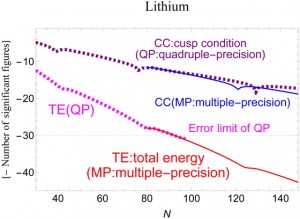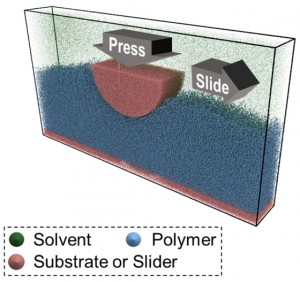[Published online Journal of Computer Chemistry, Japan -International Edition Vol.11, -, by J-STAGE]
<Title:> Accuracy of Hartree Fock Energies and Physical Properties Calculated Using Lambda Functions for Helium, Lithium, and Beryllium Atoms
<Author(s):> Yasuyo HATANO, Shigeyoshi YAMAMOTO
<Corresponding author E-Mill:> syamamot(at)lets.chukyo-u.ac.jp
<Abstract:> Multiple-precision Hartree Fock equations are solved for the ground states of the He, Li, and Be atoms and highly accurate wave functions are determined. The numbers of significant figures of the total energies are 66 for He, 43 for Li, and 43 for Be. The Lambda function, which is a Laguerre-type basis and can be used to construct a complete orthonormal system, acts as the basis function. Using the resulting Hartree Fock wave functions, nucleus-electron cusp conditions are also calculated. Their significant figures are 30 for He, 19 for Li, and 19 for Be, in close proportion to the numbers of significant figures for the total energies. In fact, the ratios are 0.45, 0.44, and 0.44, respectively. The radial expectation values, < ri > (i = -2, -1, 1, … 9), are also investigated. It is verified that the computational accuracy varies depending on the physical property.
<Keywords:> Number of significant figures, Arbitrary precision package, Hartree Fock limit, Cusp condition, Complete orthonormal system, Laguerre-type basis function
<URL:> https://www.jstage.jst.go.jp/article/jccjie/11/0/11_2024-0032/_html
<Title:> Accuracy of Hartree Fock Energies and Physical Properties Calculated Using Lambda Functions for Helium, Lithium, and Beryllium Atoms
<Author(s):> Yasuyo HATANO, Shigeyoshi YAMAMOTO
<Corresponding author E-Mill:> syamamot(at)lets.chukyo-u.ac.jp
<Abstract:> Multiple-precision Hartree Fock equations are solved for the ground states of the He, Li, and Be atoms and highly accurate wave functions are determined. The numbers of significant figures of the total energies are 66 for He, 43 for Li, and 43 for Be. The Lambda function, which is a Laguerre-type basis and can be used to construct a complete orthonormal system, acts as the basis function. Using the resulting Hartree Fock wave functions, nucleus-electron cusp conditions are also calculated. Their significant figures are 30 for He, 19 for Li, and 19 for Be, in close proportion to the numbers of significant figures for the total energies. In fact, the ratios are 0.45, 0.44, and 0.44, respectively. The radial expectation values, < ri > (i = -2, -1, 1, … 9), are also investigated. It is verified that the computational accuracy varies depending on the physical property.
<Keywords:> Number of significant figures, Arbitrary precision package, Hartree Fock limit, Cusp condition, Complete orthonormal system, Laguerre-type basis function
<URL:> https://www.jstage.jst.go.jp/article/jccjie/11/0/11_2024-0032/_html

